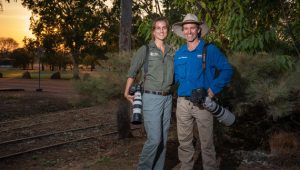Since late 2019 catastrophic and unprecedented wildfires have burned across Eastern and South Eastern Australia (New South Wales, SE Victoria and Kangaroo Island South Australia) baring devastating impacts on native birds, flora and other fauna, as well as human communities and aboriginal cultural sites.
Protected species in bushfire affected areas
The full extent of damage to habitats of Australian birds and wildlife from the bushfires is yet to be known, with estimates of over 500 million – 1.25 billion animals having fallen victim to the fires and smoke or lost their feeding and breeding grounds. Once it becomes safe to do so, large-scale ecological surveys will need to occur to assess the damage, immediate management practises and ongoing-conservation strategies.
On Monday 20 January 2020, the Australian Federal Government released an initial list of threatened and migratory species which have more than 10% of their known or predicted distribution in areas affected by bushfires in southern and eastern Australia from 1 August 2019 and 13 January 2020.
The threatened species include 272 plant, 16 mammal, 14 frog, nine bird, seven reptile, four insect, four fish and one spider species. An additional four listed migratory bird species are not listed as threatened.
Species at high risk include Regent Honeyeaters, Swift Parrot, Eastern Ground Parrot, Eastern Bristlebird, Spectacled & Black-faced Monarch and Glossy Black Cockatoos.
The Federal Government has initially released a $50m Bushfire recovery package launched for wildlife and their habitat. Read more here:
New South Wales, SE Victoria and Kangaroo Island SA have been worst affected. Australia is a vast country with much of the land mass remaining unaffected by these fires. If you have organised birdwatching activities in affected regions, please contact local tour operators or Birdlife Australia’s regional branches to check the current situation and keep ourself safe. Adhere to all emergency services advice.
2019 brought record-breaking temperatures and months of severe drought have fuelled a series of massive bushfires across Australia. Areas over half the size of Britain have burnt since late 2019/20! Some rain has been falling in affected areas but it is still not enough and we are all hoping they receive much more needed rain.
We are very thankful to advise birdwatching tours and activities in Australia’s outback and tropical north, including the Northern Territory & Western Australia Kimberley region, are not affected by the current Australian bushfires.
These tropical savannah regions in the Top End of Australia practise annual fuel reduction burns, combining traditional aboriginal fire regimes and modern scientific knowledge to manage assets and promote biodiversity. Regular ‘cool season’ burns aim to protect habitats and avoid dangerous ‘hot destructive fires’ caused by lighting or other means.
Rest assured that NT Bird Specialists’ 2020 birdwatching tours in northern Australia have not been affected by the 2019/20 eastern and south eastern Australian wildfires and the Northern Territory is open for birdwatching and bird photography tours and activities.
The fires may influence your decision of where to birdwatch in Australia, but should not prevent you birdwatching in safe areas of the country.
How you can help:
Donate:
- Birdlife Australia: Get in touch with Birdlife Australia’s Bushfire Crisis Appeal or your local birdlife Australia Branch to see what programs exist in affected areas to support the how you can help birds affected by the Australian wildfires.
- WIRES: Wildlife Rescue NSW. Rescue. Volunteer. Donate. WIRES mission is to actively rehabilitate and preserve Australian wildlife and inspire others to do the same.
- WWF: WWF Australian Wildlife and Nature Recovery Fund uses Australian bushfire donations for ‘Wildlife response, habitat restoration for people and nature, future proofing Australia’ programs.
- Support local registered wildlife organisiations providing fire-relief by volunteering your time or donating much needed resources.
- Leave water baths outside for stressed or injured wildlife and call local wildlife carers for advice.
- Create habitat with false hollows and hiding places around your home.
- Plant locally indigenous plants around your property to create new habitat and feeding sites for threatened and affected birds and wildlife.
Go birdwatching in Australia:

- Go birding in rural Australian communities and national parks. Your birdwatching trips visiting remote communities and park agencies contributes a bigger impact than just boosting your species list. Sustainable birdwatching tourism raises awareness amongst local communities about the importance of conserving habitat and local birdlife. Your tourism dollars disperse far and wide contributing to species protection in national parks and urban areas. *Make sure you contact reliable local sources for safety before birding in fire-affected areas of eastern and southern Australia.
- When booking a birdwatching tour in Australia, make sure you choose accredited and sustainable birdwatching guides and tour operators who minimise impact and maximise benefits to local birds and wildlife and local and indigenous communities.
NT Bird Specialists are proudly members of Birdlife Australia and committee members of Birdlife Top End branch. To view our full list of accreditations, visit our ‘Why Choose Us’ page.
 *This birdwatching blog was written with deep condolences for fire-affected communities, fire-fighters, conservationists and future wildlife populations by Sarah Burgess and Luke Paterson from NT Bird Specialists, Darwin, Northern Territory, Australia.
*This birdwatching blog was written with deep condolences for fire-affected communities, fire-fighters, conservationists and future wildlife populations by Sarah Burgess and Luke Paterson from NT Bird Specialists, Darwin, Northern Territory, Australia.
Banner Image credit: Black-necked Stork by Colin Baker

 View All News
View All News